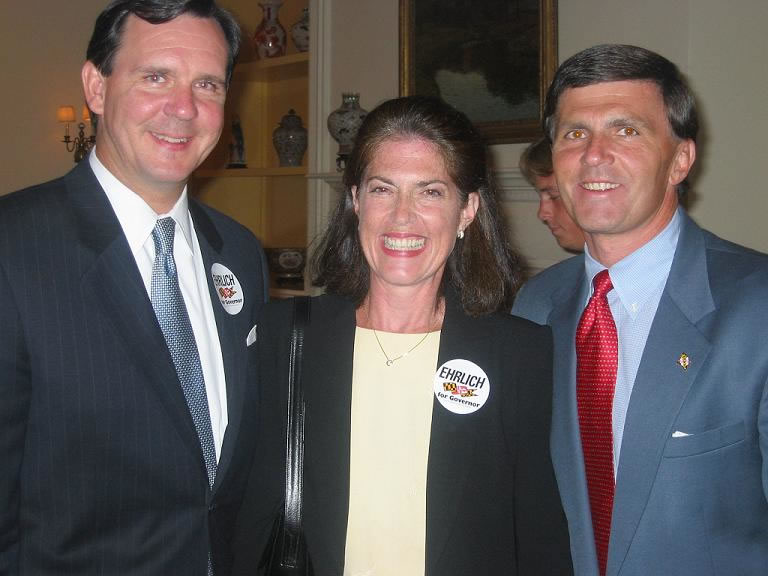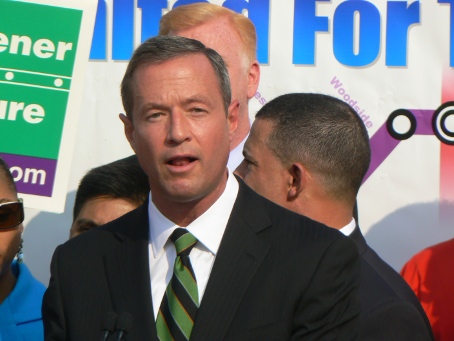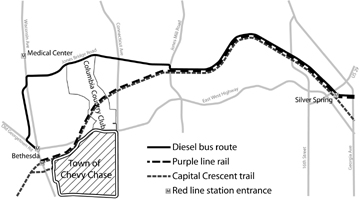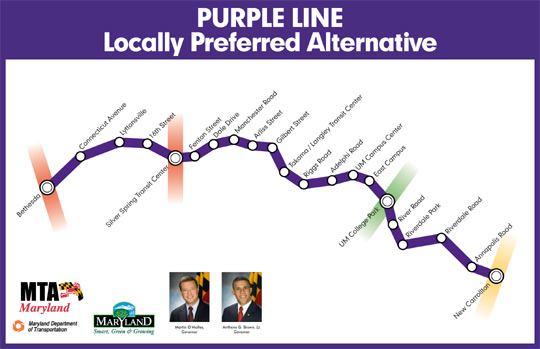The Candidates for Governor – Their Records on the Purple Line
The Purple Line is a planned light rail line that will connect Bethesda, Silver Spring, Langley Park, College Park and New Carrollton, with two stops on the University of Maryland campus.
By linking major suburban centers and existing Metro, train, and bus lines, the light rail line will offer a quality alternative to driving on the congested Beltway and will cut travel time for tens of thousands of area residents. For example, travel time from Langley Park to Bethesda will drop to about 22 minutes, far faster than is possible today. For more information about the Purple Line, please go to our Purple Line home page.
Plans to build the Bethesda-to-Silver Spring segment of the Purple Line were first announced in 1987, and the entire route has been under study since 1997. The project enjoys overwhelming popular support, but it has been repeatedly delayed by politically influential opponents, and construction is still three or four years away. The main opposition comes from Chevy Chase's exclusive Columbia Country Club, whose members don't want to look at the trains while they play golf.
The Purple Line has emerged as a major issue in this year's election for governor. The best way to judge the major candidates' positions on the Purple Line is to look at their records as governor.
Robert Ehrlich |
Martin O'Malley |
|
Former Governor Ehrlich is running as an opponent of the light rail Purple Line. |
Governor O'Malley is running for re-election as a supporter of the light rail Purple Line. |
 |
 |
| Governor Ehrlich raising campaign funds at Columbia Country Club- Photo by Patricia Metzger | Governor O'Malley announcing the decision to build the Purple Line as light rail - Photo from Washington Post. |
In 2003, the newly elected Ehrlich administration came into office after making campaign promises both to Purple Line opponents and to Washington-area commuters who want better transportation. Gov. Ehrlich chose not to kill the Purple Line outright, but instead embarked on a policy that his own appointee to the Metro board later described as “obfuscate, alter, study and delay.” Progress on light rail came to a near standstill while new bus alternatives were considered. The new option that emerged was a bus line that took the same route as light rail from downtown Silver Spring to Jones Mill Road and then deviated onto existing roads. It followed Jones Bridge Road from Jones Mill to Wisconsin Avenue, and then turned south onto Woodmont Avenue, where it continued as far as the Bethesda Metro. |
In 2006, Governor O'Malley campaigned in favor of the Purple Line and signed the Purple Line Pledge in support of light rail. Upon taking office, he chose John Porcari, a longtime Purple Line supporter who lives in Cheverly, as Secretary of Transportation. The Purple Line made slow progress in the first months of the new administration, but it gained momentum after bureaucratic hurdles were overcome in August 2007. The Draft Environmental Impact Statement – a key document that evaluates various routes and compares bus and rail alternatives – was completed in October 2008. Public hearings in November showed wide support for light rail, and in January the Montgomery County Council voted unanimously, as the Prince George's Council had earlier, to recommend light rail. |
 |
For a more detailed map, click here |
There was no secret about the reason this alternative was proposed. It wasn't transportation planning – studies quickly showed that this route would be too slow and would attract few riders. The objective was to keep transit away from Columbia Country Club. Governor Ehrlich was quoted in the Gazette as saying “It will not go through the Country Club.” Robert Flanagan, his Secretary of Transportation, offered another reason – to preserve a hiking trail. This trail happens to run through the country club – and as Mr. Flanagan conceded, “The governor happens to love golf.” In his 2010 campaign, Gov. Ehrlich flatly opposes the light rail Purple Line. He announced in May that he still prefers the bus route, and a month later he chose Potomac resident Mary Kane, a long-time Purple Line opponent, as his running mate. For her part, Ms. Kane, when she first ran for public office in 2000, explained to the Gazette that she opposed light rail between Bethesda and Silver Spring because “I see the need to go from Silver Spring to Bethesda, but I don't see the need to go from Bethesda to Silver Spring.” |
In August 2009, Gov. O'Malley made the official decision that the Purple Line will be light rail and will follow an abandoned railway line through Columbia Country Club. By using this direct route, trains can go from Bethesda to Silver Spring in less than ten minutes. In the face of a dismal budget situation, Gov. O'Malley repeatedly seized opportunities to move the Purple Line ahead. His newly proposed transportation budget for 2011 through 2017 adds $48 million in new money for the Purple Line – enough, when matched with federal funding, to cover the entire cost of engineering and designing the new rail line. In his re-election campaign, Gov. O'Malley is outspoken in his support of the Purple Line. Even when challenged by opponents of the project, he does not hesitate to state a clear position.
|

